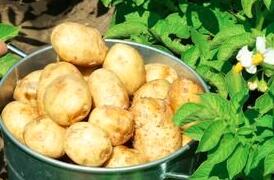The study aims to select new potato varieties suitable for cultivation in winter in Longhai District, Zhangzhou City, and to promote the green and sustainable development of the potato industry. This study selected nine new potato varieties including ‘Zhongshu 50’, ‘Minshu 12’, ‘Yunshu 109’, ‘Longshu 24’, ‘Shiyan 1’, ‘Funong 4’, ‘Funong 5’, ‘Huasong 3’ and ‘Wotu 5’ as experimental materials for variety screening, the variety ‘Favorita’ was used as the control. The results indicated that the comprehensive characters of tubers of these 9 new varieties were recognized by the market with yellow-skin, yellow-flesh and oval-shape, which were not significantly different from ‘Favorita’. Compared to the control group, the fresh potato yield of ‘Funong 4’, ‘Funong 5’, ‘Zhongshu 50’, ‘Wotu 5’, ‘Huasong 3’, ‘Minshu 12’ and ‘Shiyan 1’ were increased by 42.63%, 39.66%, 29.00%, 25.39%, 20.69%, 10.19%, and 9.56%, respectively. Conversely, ‘Yunshu 109’ and ‘Longshu 24’ showed a decrease of 19.91% and 7.37%, respectively (P<0.01). In terms of overall quality of large and medium-sized potatoes, including yield, dry matter content, and taste, the ranking was as follows: ‘Funong 5’, ‘Funong 4’> ‘Wotu 5’, ‘ Shiyan 1’, ‘Huasong 3’> ‘Favorita’, ‘Zhongshu 50’> ‘Minshu 12’, ‘Yunshu 109’, and ‘Longshu 24’. Regarding field late blight resistance, ‘Longshu 24’ and ‘Huasong 3’ were as susceptible as ‘Favorita’, while the other varieties exhibited moderate susceptibility. The growth period for each variety ranged from 83 to 89 days. Additionally, ‘Minshu 12’, ‘Longshu 24’, and ‘Zhongshu 50’ displayed varying degrees of secondary growth, hollowing, and splitting of potatoes, whereas no such physiological defects were observed in the other varieties. In conclusion, the comprehensive performance of ‘Funong 4’, ‘Funong 5’, ‘Zhongshu 50’, ‘Wotu 5’, ‘Huasong 3’, and ‘ Shiyan 1’ in Longhai District surpasses that of ‘Favorita’. It is recommended that ‘Funong 4’ and ‘Funong 5’ can be used as primary varieties, while ‘Zhongshu 50’, ‘Wotu 5’, ‘Huasong 3’, and ‘Shiyan 1’ serve as alternative varieties for demonstration and promotion in local winter potato production.
